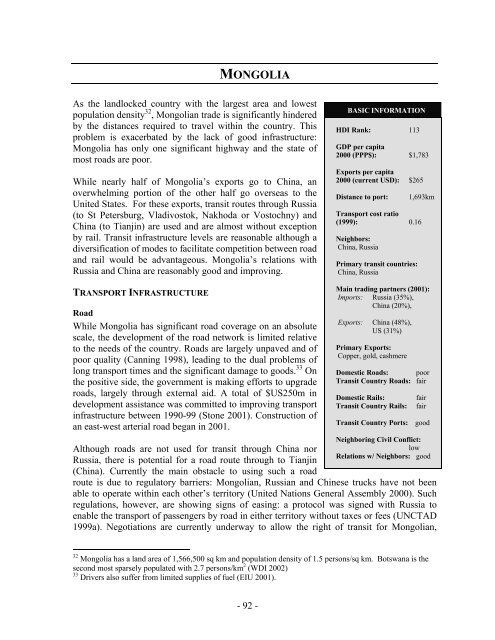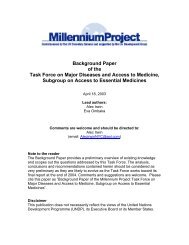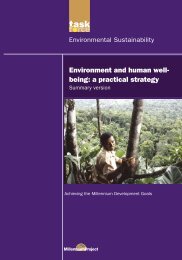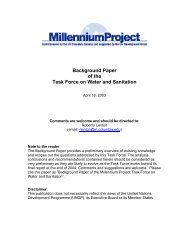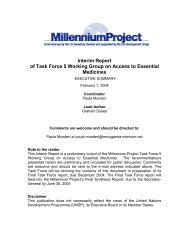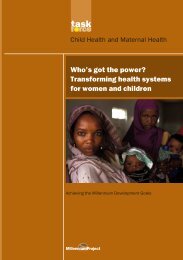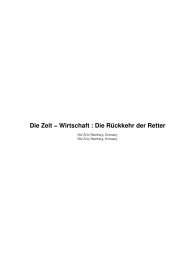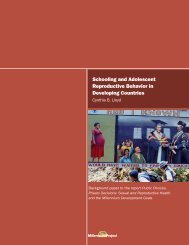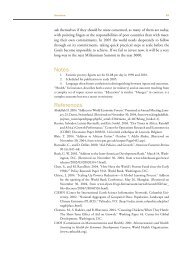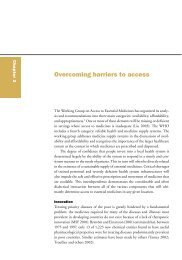the challenges facing landlocked developing countries: a case study ...
the challenges facing landlocked developing countries: a case study ...
the challenges facing landlocked developing countries: a case study ...
Create successful ePaper yourself
Turn your PDF publications into a flip-book with our unique Google optimized e-Paper software.
MONGOLIA<br />
As <strong>the</strong> <strong>landlocked</strong> country with <strong>the</strong> largest area and lowest<br />
population density 32 , Mongolian trade is significantly hindered<br />
by <strong>the</strong> distances required to travel within <strong>the</strong> country. This<br />
problem is exacerbated by <strong>the</strong> lack of good infrastructure:<br />
Mongolia has only one significant highway and <strong>the</strong> state of<br />
most roads are poor.<br />
While nearly half of Mongolia’s exports go to China, an<br />
overwhelming portion of <strong>the</strong> o<strong>the</strong>r half go overseas to <strong>the</strong><br />
United States. For <strong>the</strong>se exports, transit routes through Russia<br />
(to St Petersburg, Vladivostok, Nakhoda or Vostochny) and<br />
China (to Tianjin) are used and are almost without exception<br />
by rail. Transit infrastructure levels are reasonable although a<br />
diversification of modes to facilitate competition between road<br />
and rail would be advantageous. Mongolia’s relations with<br />
Russia and China are reasonably good and improving.<br />
BASIC INFORMATION<br />
HDI Rank: 113<br />
GDP per capita<br />
2000 (PPP$): $1,783<br />
Exports per capita<br />
2000 (current USD): $265<br />
Distance to port:<br />
1,693km<br />
Transport cost ratio<br />
(1999): 0.16<br />
Neighbors:<br />
China, Russia<br />
Primary transit <strong>countries</strong>:<br />
China, Russia<br />
TRANSPORT INFRASTRUCTURE<br />
Road<br />
While Mongolia has significant road coverage on an absolute<br />
scale, <strong>the</strong> development of <strong>the</strong> road network is limited relative<br />
to <strong>the</strong> needs of <strong>the</strong> country. Roads are largely unpaved and of<br />
poor quality (Canning 1998), leading to <strong>the</strong> dual problems of<br />
long transport times and <strong>the</strong> significant damage to goods. 33 On<br />
<strong>the</strong> positive side, <strong>the</strong> government is making efforts to upgrade<br />
roads, largely through external aid. A total of $US250m in<br />
development assistance was committed to improving transport<br />
infrastructure between 1990-99 (Stone 2001). Construction of<br />
an east-west arterial road began in 2001.<br />
Although roads are not used for transit through China nor<br />
Russia, <strong>the</strong>re is potential for a road route through to Tianjin<br />
(China). Currently <strong>the</strong> main obstacle to using such a road<br />
Main trading partners (2001):<br />
Imports: Russia (35%),<br />
China (20%),<br />
Exports: China (48%),<br />
US (31%)<br />
Primary Exports:<br />
Copper, gold, cashmere<br />
Domestic Roads: poor<br />
Transit Country Roads: fair<br />
Domestic Rails:<br />
Transit Country Rails:<br />
route is due to regulatory barriers: Mongolian, Russian and Chinese trucks have not been<br />
able to operate within each o<strong>the</strong>r’s territory (United Nations General Assembly 2000). Such<br />
regulations, however, are showing signs of easing: a protocol was signed with Russia to<br />
enable <strong>the</strong> transport of passengers by road in ei<strong>the</strong>r territory without taxes or fees (UNCTAD<br />
1999a). Negotiations are currently underway to allow <strong>the</strong> right of transit for Mongolian,<br />
fair<br />
fair<br />
Transit Country Ports: good<br />
Neighboring Civil Conflict:<br />
low<br />
Relations w/ Neighbors: good<br />
32 Mongolia has a land area of 1,566,500 sq km and population density of 1.5 persons/sq km. Botswana is <strong>the</strong><br />
second most sparsely populated with 2.7 persons/km 2 (WDI 2002)<br />
33 Drivers also suffer from limited supplies of fuel (EIU 2001).<br />
- 92 -


